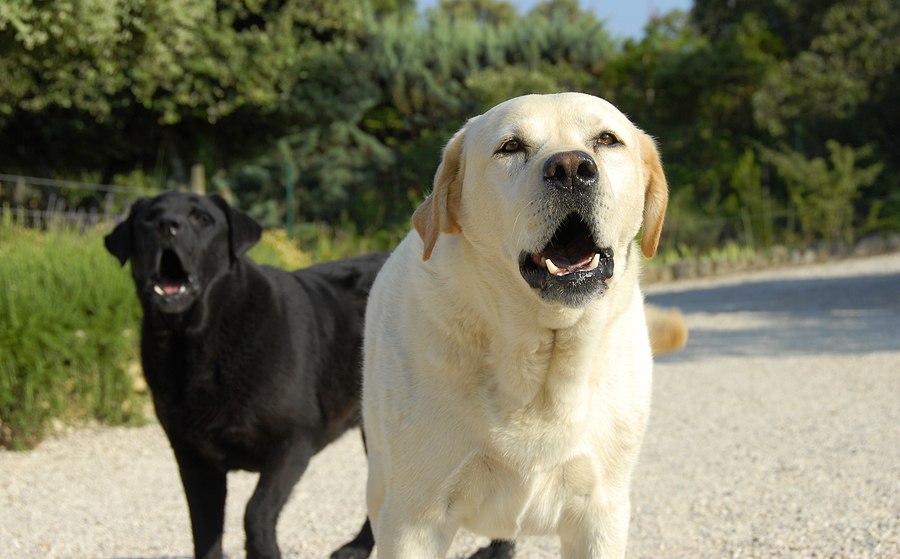Last week’s post on teaching dogs “Enough,” when you are tired of being a petting machine, elicited a request from reader Nana-Mary: “Speaking of our two dogs, I would love some tips on controlling the BARKING! I know that we don’t want to discourage ALL barking, but sometimes it gets way out of control. It’s like a game. They seem to bark to get the other one riled up. I would love to hear how to make them STOP!!”
Whaaa? Barking? Dogs? In my first month of working as an applied animal behaviorist, I literally asked a potential client–who was calling about a barking problem–to repeat herself because I couldn’t hear her. Because–you know where I’m going here–my dogs were barking.
Unlike adult wolves, who rarely bark, most domestic dogs are veritable opera singers, from bass-playing Great Pyrenees to soprano Miniature Poodles. Of course, some dogs are more vocal than others. One of my favorite online jokes is “If a tree falls in the forest, and no one is there to see it . . . A Chihuahua 500 miles away will bark at it.” [From ifunny.co] On the other hand, some dogs seem to have taken a vow of silence. Skip has barked twice since we got him almost 3 years ago. Each time, only one note: Boof. Like the dog in the children’s book, Only One Woof, by James Herriot. Bless him. I’m not a fan of noise, and it doesn’t take much to send me out of a room, holding my hands over my ears.
This photo cracks me up. I knocked on the door to get Maggie to come and bark, which she predictably did. Is Skip barking out the window with her? Nope, he’s trying to lick my face, which made getting a shot a bit tricky.
Maggie, unlike Skip, is quick to bark at visitors, cars coming up the driveway, trucks slowing down on the road, and, I swear, sometimes that tree that fell 500 miles away. So, I sympathize with anyone who would like to be able to say “Enough” to barking, not just to a solicitation for full-body massage. Maggie isn’t perfect, in that one quiet word from me does not result in her going full-out mute, but she’s pretty darned good now. Here are the most important things I’ve done myself, and advised clients to d0 that are generally effective.
DON’T BARK BACK! Most importantly, please please do all you can to refrain from barking back at your dog. Because that’s what yelling “Stop Barking!” or “Shut Up!” or saying anything, printable or not, in a loud voice is, right? Dog gets loud, you get loud back, and there you go, Bob’s your uncle, the pack is barking its head off. Barking IS contagious, that’s why it’s so much harder to squelch it if you have multiple dogs barking together. So keep it down yourself, hard as it might be sometimes.
ACKNOWLEDGE THE ALERT: If your dog is barking because there is something they think you need to know about–a car in the driveway, visitors–then I like to thank them for alerting me. I go to Maggie, look out the window with her, and thank her for the warning. “Oh yes, Maggie, thank you. I see that a branch fell down in the woods and made a thumping noise. Good to know.” Does it help? It does with Maggie, and it seems to have helped many clients, but I’m sure it wouldn’t work with all dogs. The issue, of course, is whether going to your dog is a reinforcement for their barking, or acts to relieve your dog of the burden of being the only pack member who SAW THAT A BRANCH FELL AND YOU ALL MIGHT DIE IF YOU DIDN’T KNOW ABOUT IT. You need to know your dog here, but you might give it a try if you haven’t already.
SET IT UP: Get your dog barking when YOU control the stimulus. Knock on your own door, or ring the doorbell, then follow the steps below. Now there is nothing for your dog to continue to bark at, so it’s easier to distract and reinforce them. This way you can start with an easy win and build up from there.
DISTRACT & REINFORCE: First, figure out a cue you want to use like, “Quiet Please,” or “Enough,” and pair it with something highly desirable and distracting. I started with Maggie by going to her when she was barking with a piece of cooked chicken in my hand, holding it to her nose and luring her away from the window. Once I knew that worked, I paired it with “Quiet” cue. Gradually I stayed farther away, phased out the chicken, and reinforced her with praise and play. Note that this simple explanation requires working your way up, step by step, to “real” life when your dog sees something barkable out the window.
BE PERSISTENT: Like your dog is when she’s barking, right? Maggie now comes away from the window when asked, but has trouble not belting out a few more woofs. I keep her busy–I ask her to do tricks, throw one of her toys, or anything to keep her mind off THE KIILLER BRANCH OUTSIDE. Sometimes I ask her to go into her crate (which she and Skip do for visitors at the drop of a hat), where she might bark a few times but is easily ignored because she’s in another room and it’s not very loud. I have to say, that since I’ve started going to her and acknowledging what’s she’s barking at (“Oh good girl, I see the deer across the road too, aren’t you clever!), I’ve found it is much easier to get her to stop once I’ve asked..
STAY CALM: I know, easier said than done if you have three dogs going at it at 110 decibels and you’re waiting for a raid from OSHA to fine you for a noise violation. But the more agitated you are, guaranteed, the harder it is to calm your dog and get them to be quiet.
MULTIPLE BARKERS?: First, everyone reading this please take a moment to sympathize. It’s one thing to quiet one dog, another altogether to stop a pack in full voice. As said above, barking is contagious. My best advice is to work at one dog at a time, put the others away in another room while you’re doing it, and set each dog up by pretending to be a visitor. (I should note that I rely often on having taught my dogs to go into another room (away from the doors, and where their crates are). I consider it as basic a cue as “sit” or “down.” If I was teaching a family dog training class, I’d include it!)
That’s the basics, but below I’ve copied my post from 2017, which is more detailed. I’ve amended it a bit, but hopefully there’s enough here to help get someone starting on having a quieter house.
I love it when my dogs bark as someone drives up to the farm, and I’m not alone in appreciating being alerted by a dog. Masai villagers keep dogs, they told me, because they bark when lions try to break through the thorn bush barrier to kill their cattle. Tulip, our Great Pyrenees in years past, began low, deep barking whenever she heard coyotes. In addition, her barks saved her own life one cold and snowy night–she would have died if she hadn’t barked at just the right time to help us locate her, trapped under a log in the woods.
In other words, barking is good. It’s a wonderful way of communicating, from alerting us to visitors, to signaling “help!”, to intimating individuals with dangerous intents. So yup, barking is great. Until it’s not.
Few people have a problem with a dog barking a few times. It’s how to stop the barking once one has been alerted or warned that is the challenge. This must be the derivation of one of my favorite book titles ever: HELP! I’m Barking and I Can’t be Quiet, by Daniel Estep and Suzanne Hetts of Animal Behavior Associates. Of course, it’s not the dogs who are bothered by continuous barking. It’s us. When I recently asked blog readers what they’d like to talk about, “problem barking” was number one on the list.
Aware that too much barking is a problem for many of us, I thought it would be interesting to review what a range of experts say about the issue. I delved into all the books in my library that have sections on barking. Initially I was planning to review everyone’s advice but quickly realized that I could spend many hours doing so, and most everyone’s advice came down to a few suggestions, most of them very general. I’ll just summarize by saying I was a tad surprised at how little detail there actually is on teaching dogs to stop barking–lots of advice was so general that I doubt any novice training could use it effectively. But then, stopping a dog from barking isn’t easy. If it was, I suspect I wouldn’t have gotten so many requests to address it.
It makes sense that “barking” is a tricky issue because first, there are so many different types and contexts that elicit it. From “Yo, put my dinner bowl down already” to “Oh No No No, the UPS monster is walking up the driveway,” the motivations for barking are numerous and varied.
I thought it would be helpful to begin thinking about how to deal with problem barking with advice from one of my all-time favorite classics, Karen Pryor’s, Don’t Shoot the Dog. With a tip of the hat to Ms. Pryor, here are her 8 ways to deal with any problem behavior:
Method 1: Shoot the Dog. Effective, but a bit draconian. In our case, a riff on this method would be exchanging your dog(s) for aBasenji. Except, Basenjis still vocalize and the sounds they make are, well, weird. Or you could get a cat, a lizard or a hedgehog. Individuals of these species are easy to teach to stop barking, because they never start.
Method 2: Punishment. As Ms. Pryor reminds us, (positive) punishment is a very common and human response, along with being ineffective and the least benevolent way to handle the problem. In my experience, yelling is probably the most oft-employed and the least effective method employed by owners when dogs won’t stop barking. I describe yelling at your dog to stop barking as doing little but barking back. Since barking is contagious, how would this cause your dog to stop? I found that it helps Willie and Maggie to stop barking when I join them at the window, look in the same direction as they and very quietly say “Yes, I see that. Thank You.” That is literally the opposite of yelling at dogs to stop them from barking, and I swear it seems to help them settle down.
Other oft-used punishments include spraying with water or “bark collars” that shock the dog when it barks, either automatically or because the owner hit the button. I am not a fan of “bark collars,” and that is putting it mildly. (I’ll leave it at that for now; I started writing more and realized it needs an entire blog. But see Turid Rugaas’s book Barking: The Sound of a Language for an important reminder that barking is an important part of canine behavior.) With rare exceptions, Method 2 is a lousy one. Moving on.
Method 3: Negative reinforcement. As example of this would be to stop yelling when your dog finally becomes quiet. You’ve taken something away (your yelling) to increase the frequency of your dog being quiet. Except, see Method 2 for a reminder that yelling is basically barking and accomplishes little but a sore throat for you. Dogs can seemingly bark forever without getting tired, but yelling is no fun for most of us. Moving on. . .
Method 4: Extinction, or letting the behavior go away by itself because it is never reinforced. This actually can be an effective method for many problem behaviors. It’s a tricky one with barking or whining however, because dogs seem to be able to do this for eons and eons with barely a pause. But, it could be effective for dogs who have learned to bark to get your attention. Just be prepared for the “extinction burst” when they bark five times as long before finally giving up. Moving on . . .
Method 5: Train an incompatible behavior. Jackpot! This is what works best for most of us. I’ve trained Willie and Maggie to stop barking when visitors come by teaching “Enough,” which to Willie, probably, means “move away from the window, come over to Trisha.” I’m not even sure he equates it with “no barking” (it’s hard to teach a negative after all, as in: “Don’t think about red!”). But I don’t care, because all I care about is the behavior. I say “Enough,” he stops barking, although I sometimes have to work to keep him from starting again. I deal with that by asking Willie to go pick up a toy after he gets a treat. Harder to bark with a toy in your mouth…
Barking appears to be almost involuntary for some dogs in some contexts (note I said “almost”) and I think it’s up to us to help them find ways to do something besides barking. This is, of course, especially tricky with barking because dogs can do any number of things while still barking. Sheila Booth in Purely Positive Training suggests teaching puppies “Quiet” by putting a tab of peanut butter on the roof of their mouth in association with the word. I’ve never tried this but it sounds like it has potential: Dogs can’t bark when they are sucking on peanut butter. But be careful that it doesn’t contain Xylitol and don’t use too much. Anyone tried it?
Method 6: Put the behavior on cue (and then never ask for it). I’ve suggested this to several clients, and did it myself with one of my Border Collies years ago who was a problem barker. Also a possibility, but it does feel like going backwards to some people, and can be a bit harder than it sounds.
Method 7: Shape the Absence, or reinforce “anything and everything” that is not the undesired behavior. This could be tricky with barking, because there’s usually not much time between barks. I certainly use this once I’ve gotten a dog away from the door/window and it’s focused on me, but you have to start by distracting it in my experience. Anyone else?
Method 8: Change the motivation. This might be described as another way of using classical conditioning to change an animal’s interior motivation or emotional state as a way of changing external behavior. A Functional Analysis perspective on this is to change the Antecedent conditions in the ABC formula of Antecedent, Behavior, & Consequence. (See Dr. Susan Friedman in her Living and Learning with Animals course and her many seminars and workshops for an in depth analysis of using clear and humane science-based methods to influence behavior. I’d advise moving heaven and earth to attend as many as you can.)
I’d guess that I’ve used this and Method #5 more than any other two, both in my career as a behaviorist and as a dog owner myself. In the case of barking, it works beautifully for dogs who are alarm barking because they are nervous about visitors. If visitors toss treats before entering, the dog begins to associate visitors with good things instead of threats, and the fearful barking is replaced by tail ways and silly grins. (See The Cautious Canine for details on how to do it.)
I trained “Enough” by first manipulating the environment or antecedent conditions to make success more likely. I simply loaded up with treats, walked to the door where visitors enter and knocked on it. Willie started barking, and as he did I said “Enough,” and moved a treat to his nose. And by that I mean one inch away from it, or less. When he focused on the treat, I used it to lure him away from the window just one step and then gave him the treat.This was all relatively easy, of course, because there was no real visitor and no other trigger for the barking than my knocking twice on the door.
That was step one; the next steps involved asking him to move further away from the window before getting a treat, or doing it when there was someone standing outside the window. I started with friends who wouldn’t mind standing there for longer than usual while we did the training. Each step was done one at a time, and gradually I began to put the elements together. I should say here that Willie still struggles not to bark when people are at the door; he does what I ask but then a bark will burst out of his mouth as if he belched. I actually feel for him, he clearly is trying, but I’m asking something very hard for him. That is part of why I help him by asking him to go get a toy. Nothing wrong with a little distraction.
I should add here that I also taught the BCs to run into a back room into their crates when visitors come. It was easy to teach, and it feels as though it is easier for the dogs to do than stand at the door and not bark. (Willie at least.) Just another example of teaching an incompatible behavior and changing the environment–they are much less likely to bark if they are standing at the window watching visitors get out of their car.)
It’s much easier for Maggie to stop barking when asked, but Tootsie has some barking issues too that we’ve basically ignored for a while. Writing about barking has motivated me to get working on polishing things up–so thank to all of you who asked me to write about it. I’ll keep you posted.
The last thing I want to say about barking to those of you who struggle with it is to first write down in detail exactly what barking bothers you, what elicits it and what you’d like your dog to do in its place. And please join in with your own experiences: What barking bothers you, what doesn’t? How have you handled it? What has worked best, or not worked at all?
Woof.
BACK TO THE PRESENT: Well. That was a lot. Perhaps you were tempted to say “Enough!” to me? But, hopefully, it will be helpful; barking can be a tricky issue to deal with–no quick answers I’m afraid. Care to join in the bark fest? What do you do? What don’t you do, which is as important? I hope this helps Nana-Mary, not to mention others, let us know!
MEANWHILE, back on the farm: Winter arrived with the time change, but a girl can still work in the garden if she puts hand warmers in her nitrile gardening gloves, right? It’s been in the 30’s, but I can work outside for an hour or so before my fingers get too cold. Jim, bless him, fills the wagon up with mulch, and I weed, weed, weed in the ice cold soil, and then spread the mulch. (Thank you Duluth Trading Company for your lined pants! They keep me so toasty.)
I love our colorful tubs from Gardener’s Supply. Here’s the garden I’m working on, the Day Lily garden that is a riot of color in summer.
There are still a few flowers blooming, like this native Honeysuckle Vine. Love it.
A girl can’t live on flowers alone. I made a carmelized onion, bacon, and cheese quiche last night. Yum. Does eating lentil soup for lunch make up for it?
It’s only appropriate to close with a photo of a dog! Here’s a shot of Skip I got a few weeks ago, during the evening after-dinner walk. He’s looking, of course, for the sheep.
Here’s to beautiful skies for all of us. Let us know your best tips for stopping barking on cue. I’m all ears!









